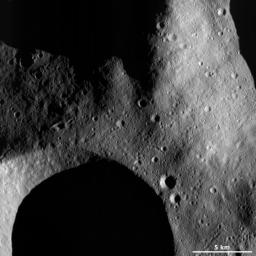This Dawn Framing Camera (FC) image of Vesta shows a part of a large subdued crater in the top left of the image. A lot of this crater is in shadow but a part of its rather degraded and rounded rim can be distinguished because of the shadow that it casts inside of the crater. In contrast, in the bottom left of the image a part of a large fresh crater can be seen. The rim of this crater is much sharper because it is younger and has not been around long enough for its rim to become as rounded as the rim of the degraded crater. There are also many smaller craters visible in this image. Some of these small craters in the bottom right of the image appear to be arranged into chains of craters.
This image is located in Vesta's Caparronia quadrangle, in Vesta's northern hemisphere. NASA's Dawn spacecraft obtained this image with its framing camera on March 23, 2012. This image was taken through the camera's clear filter. The distance to the surface of Vesta is 229 kilometers (142 miles) and the image has a resolution of about 21 meters (69 feet) per pixel. This image was acquired during the LAMO (low-altitude mapping orbit) phase of the mission.
The Dawn mission to Vesta and Ceres is managed by NASA's Jet Propulsion Laboratory, a division of the California Institute of Technology in Pasadena, for NASA's Science Mission Directorate, Washington D.C. UCLA is responsible for overall Dawn mission science. The Dawn framing cameras have been developed and built under the leadership of the Max Planck Institute for Solar System Research, Katlenburg-Lindau, Germany, with significant contributions by DLR German Aerospace Center, Institute of Planetary Research, Berlin, and in coordination with the Institute of Computer and Communication Network Engineering, Braunschweig. The Framing Camera project is funded by the Max Planck Society, DLR, and NASA/JPL.
More information about Dawn is online at http://www.nasa.gov/dawn and http://dawn.jpl.nasa.gov.

 Planetary Data System
Planetary Data System












